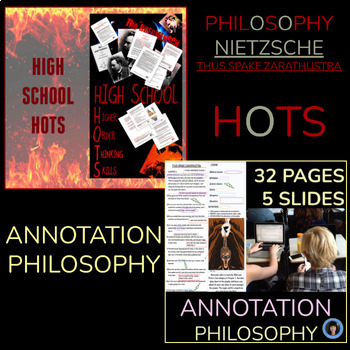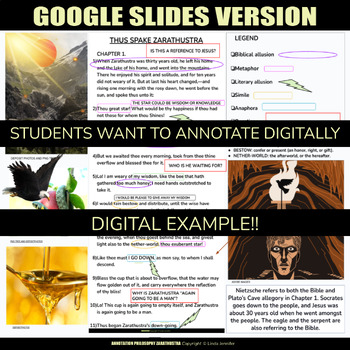ANNOTATING | ANNOTATION GUIDE | CRITICAL THINKING, PHILOSOPHY, ANNOTATING
- Zip
- Google Apps™

Products in this Bundle (2)
Also included in
- Argumentative text, NIETZSCHE, SOCRATES, ARISTOTLE, argumentative writingJust added Tinker v. Des Moines so page numbers have changedNEW PRODUCTS ADDED SO NOW 1070 PAGES and 464 SLIDESNOW 34 productsAre you looking to inspire intellectual curiosity in your students and teach them the works of some oPrice $75.99Original Price $151.76Save $75.77
Description
ANNOTATING | ANNOTATION GUIDE | CRITICAL THINKING, PHILOSOPHY, ANNOTATING
PERFECT PAIRING: NIETZSCHE'S ZARATHUSTRA AND ANNOTATION FOR THUS SPOKE ZARATHUSTRA
(20% discount)
➿ANNOTATION & CLOSE READING
ChatGPT SOLUTIONS
amazing examples, instructions for teachers and students
Using a yellow highlighter has become an annotation staple for high school students. Is this the best way to mark up a textbook or novel? Studies have shown that highlighters hinder retention and comprehension. Simple highlighting encourages a passive reading style rather than an active one. Students do not engage critically with the text when annotating with a simple highlighter. They are trying to absorb it all without really understanding it. So what is the alternative? A better way to annotate is to try my Interpretive Note-taking/Annotation, where a series of suggestions prompt students.
CHATGPT AND AI ESSAY GENERATION IS THE NEW REALITY
Cheating has unfortunately become an ongoing issue in students’ education. With the development of essay generators like ChatGPT, it is too easy for students to acquire quick and plagiarized essays. Educators should be mindful of this issue when assigning essays, but what to do? There are plenty of alternative projects that foster students’ critical thinking skills effectively! This close reading/annotation product encourages students to take annotation to the next level. This assignment is perfect for assessing their reading comprehension and students retain what they learn. I find this assignment rewarding for my students – a helpful way to study, a unique assignment, and a way to engage visual learners. I am always surprised by their work. A final bonus is that my students’ grades increased by 30% after using this assignment when preparing for exams.
CUSTOMER COMMENTS:
- This is my new favorite go-to!
- I'm really enjoying this resource with my seniors and I believe it will be very helpful to them when they transition to college.
INCLUDED IN THIS PRODUCT ARE THE FOLLOWING:
✺ 18 INDIVIDUAL PROMPTS IN SLIDES AND PRINT.
✺ 18 GROUP PROMPTS IN SLIDES AND PRINT.
✺ 26 LITERARY TERMS OR RHETORICAL DEVICES LISTED AND DEFINED IN SLIDES AND PRINT.
✺ INSTRUCTIONS FOR TEACHERS AND STUDENTS.
✺ 13 PAGES OF STUDENT EXAMPLES! Examples are from my own classes with permission. I find examples help students understand your expectations. The examples are from the first few chapters of the Prologue of Thus Spake Zarathustra.
✺ A link to file for students to use interactively through Classroom™ or other online programs.
✺ Editable instructions for students when using the interactive version.
✺ Information on Google Slides™ for teachers and students.
➿Higher Order Thinking Skills/High School HOTS #1 Nietzsche (Non-fiction)
This is a self-contained product on higher-order thinking skills/textual analysis. Everything you need is here.
MOVE AWAY FROM GENERIC QUESTIONS AND INTO TEXT-BASED ASSIGNMENTS WITH THIS UNIT ON CRITICAL THINKING, READING, AND WRITING
TEACHER TIP:
You don’t need to teach entire works, just short excerpts of the Great Books, to engage students in complex, higher-order thinking and other skills deemed essential in the new CCSS guidelines.
ANALYZING THE GREAT BOOKS: Nietzsche’s Thus Spake Zarathustra (small extract only)
Thus Spake Zarathustra is a fantastic text to engage your students in philosophical questions.
They will immediately recognize some of Nietzsche’s concepts: the superman or Ubermensch; God is dead; contempt for the herd.
Take part in the “Big Ideas” spoken about in the new CCSS guidelines; this unit will help guide your students through this difficult, yet accessible, text.
INCLUDED IN THIS PRODUCT ARE THE FOLLOWING:
✺A brief introduction
✺FOUR PAGES OF TEACHER NOTES
✺Information on how I use the text
✺CCSS related information on text complexity
✺A multiple-choice test (based upon the included reading) with answers (in the main file and as a separate PDF)
✺Critical Lens Quotation Practice (in the main file and as a separate PDF)
✺Some information on Nietzsche in popular culture
✺Chapters 1 to 4 of the Prologue from Thus Spake Zarathustra (in the main file and as a separate PDF)
✺Essay Questions (10 main with another 10+ sub-questions) (in the main file and as a separate PDF).
Thus Spake Zarathustra is sometimes called a philosophical novel; however, it is hard to define categorically. It is undoubtedly one of the most interesting philosophical texts ever written; it is rich in allegory, imagery, symbolism, and many other literary elements. It is rife with ambiguity; it is perplexing, oracular, and equivocal; hence, a wonderful work to explore – especially in a classroom.
Related Products
• Higher Order Thinking Skills/High School HOTS #2 (THE REPUBLIC)
Customer Tips:
How to get TPT credit to use on future purchases:
• Please go to your My Purchases page (you may need to login). Beside each purchase you'll see a Provide Feedback button. Simply click it and you will be taken to a page where you can give a quick rating and leave a short comment for the product. I value your feedback greatly as it helps me determine which products are most valuable for your classroom.
Be the first to know about my new discounts, freebies, and product launches:
❤️ Click HERE to become a follower. You will now receive customized email updates about this store.
Copyright © jellycat-in-the-snow productions
All rights reserved by author Permission to copy for single classroom use only Electronic distribution limited to single classroom use only
Please remember that any of the products that you download from my store are my copyrighted property and licensed only for you to share with your direct students. If another teacher wants to use these same products, they will need to purchase them directly from my TpT store, or you may purchase an additional license for them. None of my products may be shared online. Posting of my copyrighted materials may happen only in a password-protected environment, such as Google Classroom, and accessed only by your students. Posting on public websites (WordPress, Blogger, Facebook Groups, etc.) is strictly prohibited.






